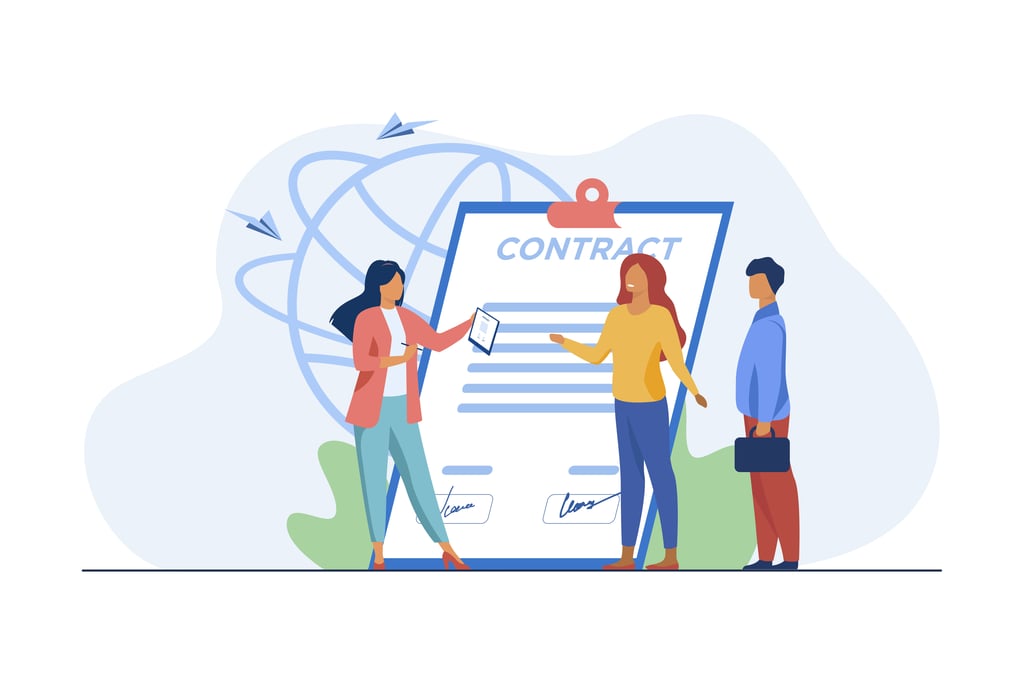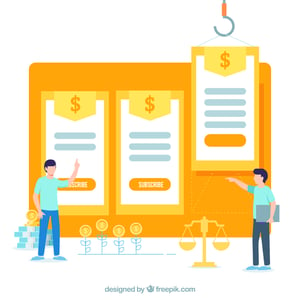Decoding Contracts: The Art of Contract Abstraction

Contracts are the backbone of any business transaction, governing relationships and ensuring that all parties involved are protected. But let’s face it – contracts can be complex, lengthy, and often filled with legal jargon that can make your head spin.
That’s where contract abstraction comes in. It is an art form that takes these intricate documents and distils them down to their most essential elements. In this blog post, we look into the world of contract abstraction, understanding its importance, process, key elements to look for in a contract, common challenges faced while abstracting contracts, benefits of using technology in contract abstraction, and tips for effective contract abstraction.
Understanding the Importance of Contract Abstraction
Contracts are the lifeblood of any business. They outline the rights, obligations, and expectations of all parties involved in a transaction. However, contracts can often be lengthy and filled with complex legal language that can make them difficult to digest.
This is where contract abstraction comes into play. Contract abstraction is the process of distilling the key information from a contract into a concise and easily understandable format. It allows procurement professionals to quickly identify important clauses, deadlines, payment terms, and other crucial details without having to sift through pages upon pages of text.
The importance of contract abstraction cannot be overstated. By abstracting contracts, businesses can save valuable time and resources while ensuring that they have a clear view of their contractual obligations and entitlements. It also helps in identifying potential risks or opportunities hidden within the agreement.
Contract abstraction enables organizations to manage their contracts more effectively by providing them with actionable insights into their contractual relationships. With this bird’s-eye view, businesses can make informed decisions about renewals, negotiations, or even potential disputes.
In addition to its operational benefits, contract abstraction also plays a critical role in risk management and compliance efforts. By systematically abstracting key terms from contracts across an organization’s portfolio, it becomes easier to identify areas where there may be inconsistencies or non-compliance with internal policies or external regulations.
The Process of Contract Abstraction
The process of contract abstraction is a crucial step in effectively managing contracts and ensuring compliance. It involves extracting key information from a contract and summarizing it in a concise and organized manner.
To begin the process, the contract is carefully reviewed to identify important clauses, terms, and obligations. This includes analyzing sections such as payment terms, termination provisions, intellectual property rights, and dispute resolution mechanisms.
Once these elements are identified, they are abstracted into a structured format that highlights their significance. This can be done using various tools or software that automate the extraction process and provide templates for organizing the information.
During the abstraction process, it is essential to pay attention to details and capture all relevant data accurately. Any discrepancies or ambiguities should be flagged for further review.
Contract abstraction requires not only legal expertise but also an understanding of business objectives and industry-specific requirements. It calls for collaboration between legal teams, procurement professionals, and other stakeholders involved in contract management.
By effectively abstracting contracts, organizations can gain insights into their contractual obligations, identify potential risks or opportunities hidden within agreements ,and make informed decisions based on accurate information.
Key Elements to Look for in a Contract
When it comes to contracts, it’s crucial to pay attention to the key elements that can make or break your procurement process. These elements serve as the building blocks of a successful contract and ensure that all parties involved are on the same page.
First and foremost, you need to look for clear and unambiguous language. A well-drafted contract should leave no room for misinterpretation or confusion. It should clearly outline the rights, obligations, and responsibilities of each party involved.
Next, consider the scope of work outlined in the contract. This section defines what exactly will be delivered or performed under the agreement. Make sure it aligns with your requirements and expectations.
Another important element is pricing and payment terms. Ensure that all costs are clearly stated and understood by both parties. Pay attention to any hidden fees or clauses that may impact your budget down the line.
Furthermore, keep an eye out for termination clauses. These specify how either party can end the contract before its completion date if necessary. Understanding these provisions will help you navigate potential issues in case things don’t go as planned.
Check for any intellectual property rights provisions if applicable. This ensures that ownership of any created materials or inventions remains with the appropriate party after project completion.
By carefully examining these key elements within a contract, you’ll be better equipped to make informed decisions during your procurement process
Common Challenges in Contract Abstraction
One of the common challenges faced by organizations in contract abstraction is the sheer volume of contracts they have to deal with. With numerous contracts to review and analyze, it can become overwhelming to manually extract important information from each one.
Another challenge lies in ensuring accuracy during the abstraction process. Contracts often contain intricate legal language and specific terms that must be accurately interpreted and abstracted. Any errors or omissions could result in significant consequences for the organization.
Furthermore, inconsistency across different contracts poses a challenge in contract abstraction. Each contract may be structured differently and use varying terminology, making it difficult to create standardized abstracts that are easy to compare and analyze.
Additionally, keeping track of key dates, obligations, and milestones outlined in contracts can be challenging. Missing important deadlines or failing to meet contractual obligations can lead to financial losses or damaged relationships with clients or vendors.
Relying solely on manual processes for contract abstraction can prove inefficient and prone to human error. It becomes essential for organizations to adopt technology solutions that streamline the abstraction process, improve efficiency, reduce costs, enhance accuracy, and ensure compliance.
Overcoming these challenges requires expertise in both legal knowledge and technology tools designed specifically for contract management purposes.
Benefits of Using Technology in Contract Abstraction
Technology has revolutionized the way businesses operate across industries, and contract abstraction is no exception. By incorporating technology into the contract abstraction process, organizations can reap numerous benefits that enhance efficiency and accuracy.
One of the key advantages of using technology in contract abstraction is the ability to automate manual tasks. Traditionally, contract abstraction involved manually reviewing each document and extracting relevant information. This was a time-consuming and error-prone process. However, with advanced software solutions, such as AI-powered contract management platforms, organizations can automate much of this labor-intensive work. This not only saves time but also reduces human errors.
Another benefit is improved accessibility and collaboration. Technology allows contracts to be stored digitally in one centralized location that can be accessed by authorized individuals from anywhere at any time. This facilitates seamless collaboration among team members working on different aspects of a project or legal matter.
Furthermore, technology enables efficient data extraction and analysis. Contract management systems equipped with machine learning capabilities can extract important data points from contracts quickly and accurately. These extracted data points can then be used for further analysis or integration into other systems for streamlined workflows.
Moreover, utilizing technology in contract abstraction enhances compliance efforts by ensuring consistency in abstracting key terms and clauses across multiple contracts. With standardized templates built into software platforms, organizations can ensure that all relevant information is consistently captured during the abstraction process.
In addition to these benefits, leveraging technology in contract abstraction also improves risk management by enabling better monitoring of contractual obligations and deadlines through automated alerts and notifications.
Incorporating technology into the contract abstraction process offers significant advantages like automation of manual tasks, improved accessibility and collaboration, efficient data extraction and analysis capabilities, enhanced compliance efforts,and better risk management practices
Tips for Effective Contract Abstraction
1. Understand the Purpose: Before diving into contract abstraction, it is essential to understand the purpose and objectives of the contract. Clearly define what information you are looking for and how it will be used.
2. Create a Consistent Framework: Establish a standardized approach to contract abstraction by creating a template or checklist that outlines the key elements to extract from each contract. This ensures consistency across all contracts and makes it easier to compare and analyze the data.
3. Use Technology Tools: Leverage technology tools specifically designed for contract management and abstraction. These tools can automate many aspects of the process, making it faster, more accurate, and less prone to human error.
4. Pay Attention to Detail: When abstracting contracts, accuracy is crucial. Make sure to carefully review each clause, provision, term, date, obligation, and any other relevant information in order not to miss anything important.
5. Collaborate with Legal Experts: Work closely with legal experts who have experience in contract law during the abstraction process. They can provide valuable insights and guidance on interpreting complex clauses or terms.
6. Regularly Update Abstracts: Contracts are living documents that can change over time due to amendments or renewals. It’s important to regularly update your abstracts as new versions of contracts are signed or modifications occur.
7. Communicate Effectively: Maintain clear communication channels with stakeholders involved in the contract management process – including procurement teams – so that everyone understands their roles and responsibilities throughout abstraction exercises.
By following these tips for effective contract abstraction within procurement processes, organizations can streamline operations while ensuring compliance with legal requirements!
Conclusion
In today’s fast-paced business world, contract abstraction has become an essential process for organizations across various industries. By extracting key information from complex contracts, businesses can streamline their procurement processes and mitigate potential risks.
Contract abstraction is the art of distilling large volumes of legal documents into concise summaries that highlight crucial elements such as terms, obligations, deliverables, and deadlines. This allows companies to quickly identify important clauses and make informed decisions based on accurate data.
The process of contract abstraction involves carefully reviewing each document and extracting relevant information in a standardized format. Key elements to look for include parties involved, payment terms, termination clauses, intellectual property rights, confidentiality provisions, dispute resolution mechanisms, and more. Having a clear understanding of these critical details helps organizations effectively manage their contractual relationships.
However, contract abstraction can be challenging due to the sheer volume of contracts that companies often deal with. Additionally, deciphering legal jargon and ensuring consistent interpretation can be time-consuming tasks. To overcome these challenges efficiently and accurately, leveraging technology solutions specifically designed for contract management is crucial.
Technology plays a vital role in streamlining the contract abstraction process by automating manual tasks like data extraction and standardizing templates for easy analysis. Advanced software equipped with artificial intelligence (AI) capabilities can scan through thousands of documents within minutes while ensuring accuracy in identifying key provisions.

